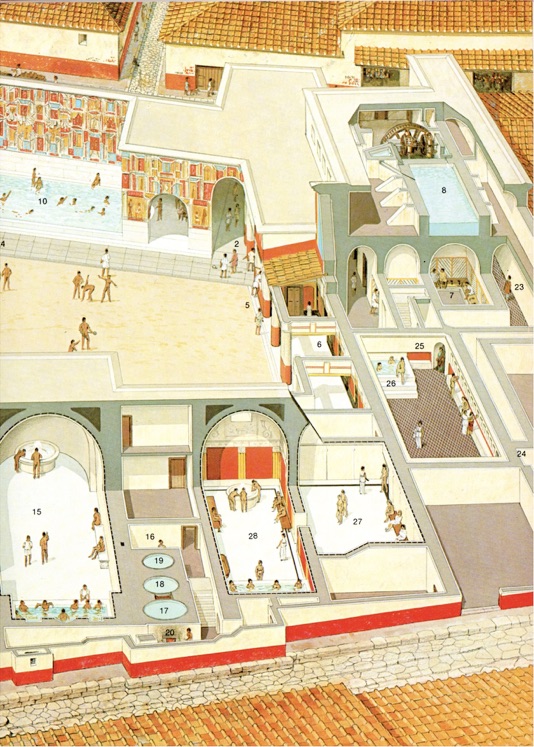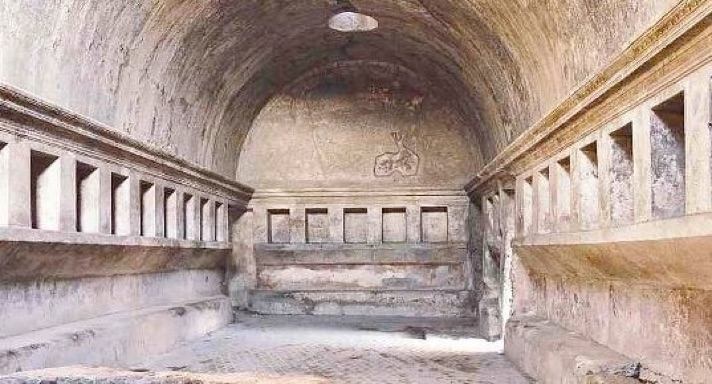Archaeological tours, packages and exclusive multy day excursions in Campania for tourists, lovers,
scholars and students.





Archaeological tours, packages and exclusive multy day excursions in Campania for tourists, lovers,
scholars and students.
Pompeii, with its testimony has contributed significantly to the knowledge of the history of the Roman baths. In the city, were found five public buildings thermal, and some of the richest households, as the House of Menander and the House of the Labyrinth, were equipped with a private a thermal area.
The Terme Stabiane, that take their name from the Street of Stabiae that runs alongside, are the most ancient establishment in town. It dates back to III century. B.C. suffered following reconstruction. The thermal plant has two separate entrances, the south wing for men and women on the wing to the north. Between the two areas was instead an environment, the praefurnium, where were the boilers for heating. The interspaces running under the floor (generated through columns of bricks calls suspensurae) and along the side walls (created through the tiles provided with spacers, called tegulae mammatae) were crossed by the air produced in the hot paerfurnium, thereby heating the thermal rooms.
In the building we can distinguish several architectural phases, in which an older small bathrooms overlooked, according to Greek tradition, a large gymnasium, and more recently during which they were built innovative specific environments. As the changing rooms (apoditeria), rooms with vaulted ceilings on the sides of which were placed in the niches to lay their clothing, and pool halls for cold baths (frigidaria); warm environments (tepidaria) used for relaxation and massage; hot baths (calidaria), and the rooms for cleaning with the strigil (destrictaria).
At the center of the gym is the pool (natatio) was accessed through two rooms along the short sides, one of which is connected to another room, probably a dressing room with beautiful decorations in IV style depicting Jupiter, Hercules, a satyr, nymphs and athletes.
In the vicinity of the Forum are, however, called the Baths of the Forum. They probably built in the early years of the colony of Sulla, as evidenced by an inscription found on via the Forum, in which reference is made to the magistrates that appaltarono the work. The thermal baths have a simpler structure and lower than Stabiane. The plant could be accessed from multiple inputs, the alley of the Baths for women, and via the Forum and Via delle Terme for men. The field of male and female are on the sides of the furnaces (praefurnia), and both were fitted with a apoditerium, a frigidarium, a tepidarium and a caldarium.
The space is definitely the most charming men in the area tepidarium, both for the well-preserved vault decorated with stucco reliefs, that the magnificent terracotta telamons pareteti that adorn the side. Of considerable importance is the heating system of this room, consisting of a large bronze brazier offered to citizenship dall'evergeta Marcus Nigidus Vaccula. The heating by means of a brazier fell into disuse towards the end of the century. BC, but was reintroduced in these baths, probably due to the damage caused by the earthquake of 62 AD.
The largest thermal baths called Terme Centrali, were still under construction at the time of the eruption. It began to build after 62 AD, and their implementation were demolished all the houses of an entire insula, which was recovered very material for the construction of the bare walls. This thermal structure was different from others found in Pompeii, and presented the architectural innovations introduced in the imperial era. The main entrance was in the process of Nola and was armed with two small rooms, a ticket and, likely, storage objects. There was a female sector (probably men and women used the building at different times), and all the baths were lit by large windows. There was no frigidarium, and is passed directly from the dressing room to the heated tepidarium with the system of walls, recessed, and then through a laconicum (corridor), the caldarium.
The Suburban Baths were, as the name implies, outside the walls, near the Porta Marina. They were built in the early decades of the I century. a. C., but underwent several changes over the years. They are extraordinarily beautiful decoration in squares of stucco of the frigidarium, they appear winged victories, cupids and river gods, and the mosaics and paintings representing marine landscapes and symbols of the divine nymph found in the same habitats. Of particular interest also are the sixteen panels of erotic dressing (including also a Sapphic scene) in which it recognizes, according to some interpretations, the explicit reference to sexual practice in the building.
The Terme of the Sarno consist of a huge block of four levels which takes its name from a painting IV style depicting the river Sarno. These baths were built in the II century. a. C. from existing houses, and expanded in the mid-first century. BC, but were severely damaged by the earthquake of 62 AD The thermal rooms were real at the fourth level, and were still being renovated at the time of the eruption. Into the Frigidarium In addition to painting representing the Sarno, runs a frieze adorned with a beautiful landscape Nilotic and Pygmy. The gym, which occupies most of the complex, offers rich scenes with athletes and fight scenes.

reconstruction of the thermal baths in Pompeii

Apodyterium in Terme Stabianae in Pompeii
THERMAL BATHS IN POMPEII
Pompeii Tour guide - Herculaneum Tour guide - Stabiae Tour guide - Oplontis Tour guide - Naples Tour guide
Amalfi Coast - Sorrento - Positano - Paestum Tour guide - Capua Amphitheater - Procida - Ischia - Capri
Copyright © Pompeiin.com - E-mail: info@pompeiin.com

